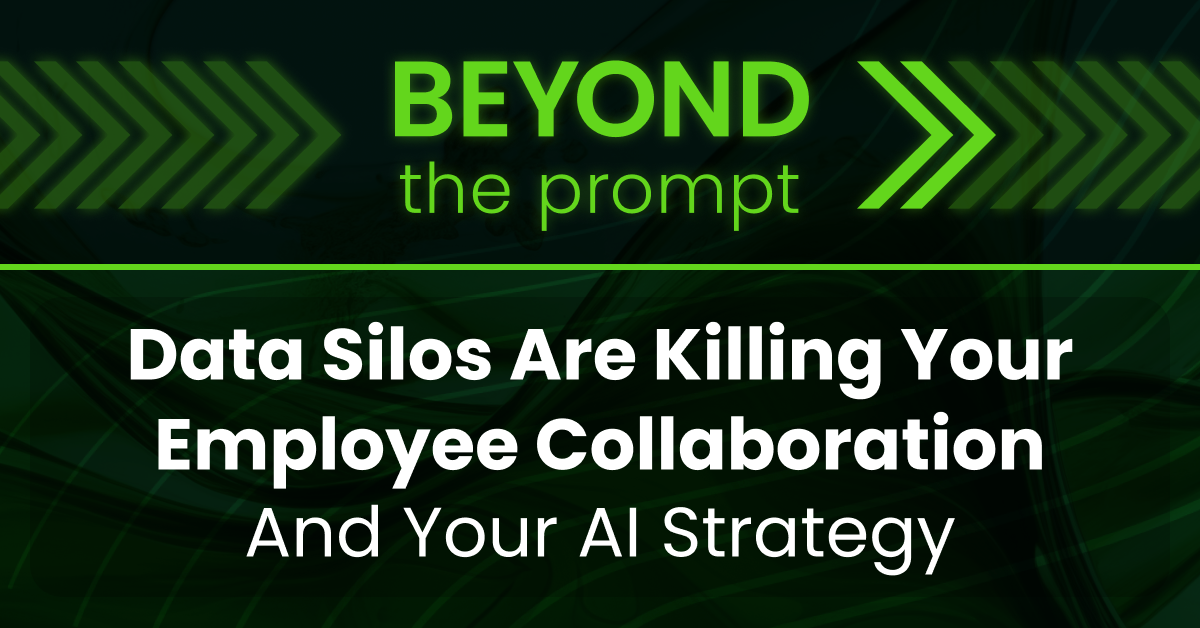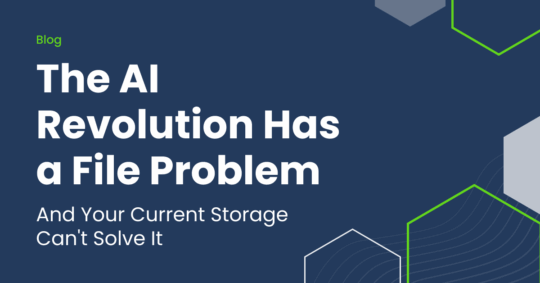Data Silos Are Killing Your Employee Collaboration (And Your AI Strategy)
In his new Beyond the Prompt series, Jim Liddle discusses how data silos impact enterprise AI strategies… and how to get around them.
June 19, 2025 | Jim Liddle

Digital transformation was supposed to unify organizations. The promise was that cloud technologies would break down barriers, connect teams seamlessly, and create frictionless collaboration across the enterprise.
Yet for many organizations, they’ve experienced the opposite. In the race toward digital transformation, companies have inadvertently created more data silos than ever before — fragmenting information, complicating workflows, and crippling their ability to not only collaborate, but also to leverage the AI wave effectively.
The consequences extend far beyond just being an inconvenience. Modern file data silos are undermining productivity, stifling innovation, and eroding competitive advantage. Perhaps most concerning, many organizations didn’t even recognize the problem until they started to understand that to really leverage AI, a unified data set is required.
The Invisible Crisis: Modern Data Silos
Today’s data silos look different from their predecessors. They’re not just departmental databases or legacy systems, they’re fragmented file repositories scattered across geographic locations, cloud services, and applications. These modern silos manifest as described below:
Geographic Fragmentation
As organizations expand globally and embrace remote work, files inevitably become scattered across locations. This creates situations where:
- Teams in different offices work with different versions of the same files
- Regional operations develop location-specific file repositories
- Remote workers create personal file caches on local devices
- Branch offices implement makeshift file servers to address performance issues
Cloud/On-Premises Divides
Perhaps the most common modern silo emerges from hybrid infrastructure approaches where:
- Cloud migration efforts leave critical files split between on-premises and cloud storage
- Different departments adopt different cloud storage solutions
- Security concerns create artificial boundaries between sensitive and non-sensitive file storage
- Performance requirements drive certain workloads to remain on local infrastructure
The Collaboration Breakdown: Quantifying the Impact
There are real consequences of fragmented file environments:
- Knowledge workers can spend more time per week simply searching for files across multiple repositories
- Employees can end up working on outdated document versions due to file access challenges
- Cross-functional projects in siloed organizations take longer to complete than in organizations with unified file infrastructure
- File-sharing friction becomes a real barrier to effective remote/hybrid work
The core issue isn’t just wasted time; it’s the fundamental breakdown of collaboration that occurs when file data is fragmented across the enterprise.
Why Point Solutions Fail
Many organizations attempt to address these challenges with point solutions such as file sync and share tools, cloud storage migration, or collaboration platforms. While these approaches may provide temporary relief, they consistently fail to solve the underlying problem for three key reasons.
1. They Add Complexity, Not Simplicity
Each new tool introduced to bridge silos actually creates another destination for file data. This expands the fragmentation problem rather than solving it.
2. They Prioritize Sharing Over Collaboration
Most point solutions focus on the act of sharing files rather than supporting true collaboration. Real collaboration requires:
- Simultaneous access to the same files without version conflicts
- Global file locking to prevent overlapping edits
- Consistent permissions and access controls
- Performance that doesn’t degrade with distance
- Unified access to all content
File sync and share tools deliver only a fraction of these requirements and create an illusion of collaboration while perpetuating many of the same challenges.
3. They Create New Governance Challenges
As files spread across multiple systems, fundamental governance questions become increasingly difficult to answer:
- Which version of this file is authoritative?
- Who has access to which copies of sensitive data?
- How are retention policies enforced consistently?
- Where are all copies of regulated information stored?
- How is file ownership maintained when employees change roles?
- Where is the ‘gold copy’?
Each additional system exponentially increases governance complexity undermining the compliance benefits these tools promise to deliver.
Beyond Silos: A Unified Approach to Enterprise Files
Overcoming modern data silos requires more than point solutions or incremental improvements. It demands a fundamentally different approach to file infrastructure, one built around a single-source-of-truth that spans locations, applications, and infrastructure models.
This approach must deliver the following.
1. A Global File System with Local Performance
The foundation of effective cross-location collaboration is a unified file system that:
- Spans all geographic locations with a single namespace
- Delivers local-like performance regardless of user location
- Eliminates the need for file duplication or synchronization
- Provides consistent file access experience everywhere
2. Universal Accessibility with Controlled Access
Breaking down silos requires making files universally available while maintaining appropriate controls:
- Consistent permission models across all access methods
- Seamless integration with identity management systems
- Attribute-based access control for complex organizations
- Detailed audit capabilities for sensitive content
3. Application Integration without Fragmentation
Modern workflows span multiple applications, requiring file infrastructure that:
- Provides standard interfaces for application integration
- Maintains file consistency across application boundaries
- Eliminates application-specific storage silos
- Enables unified access to all content
4. Infrastructure Flexibility without Compromise
Effective file collaboration must span infrastructure models:
- Bridging on-premises, cloud, and edge environments
- Eliminating artificial boundaries based on infrastructure choices
- Supporting seamless migration between infrastructure models
How Nasuni Eliminates Data Silos Once and For All
Nasuni’s global file system was designed specifically to overcome the modern data silos that undermine cross-location collaboration. Unlike point solutions that address symptoms rather than causes, Nasuni’s architecture delivers a fundamentally different approach, outlined below.
A Single Source of Truth
At the core of Nasuni’s architecture is UniFS®, a global file system that spans all locations while maintaining a single source of truth. It provides:
- One authoritative version of every file, accessible from anywhere
- Consistent file structure and naming across the enterprise
- Global search capabilities across all content
- Unified governance and compliance controls
Local Performance with Global Reach
Nasuni eliminates the traditional trade-off between local performance and global accessibility:
- Edge appliances in each location cache active files for LAN-speed access
- Global file locking prevents version conflicts during collaboration
- Background synchronization ensures consistency without user intervention
- New locations can be added without complex migration projects
True Cross-Location Collaboration
Unlike file sync and share tools that simply move copies around, Nasuni enables genuine collaboration:
- Real-time file locking prevents conflicting edits
- All users see the same file structure regardless of location
- Changes are immediately visible across the organization
- No user training required — just standard file access methods
Infrastructure Independence
Nasuni transcends the artificial boundaries created by infrastructure choices:
- Cloud-scale capacity with on-premises performance
- Consistent experience regardless of underlying infrastructure
- Seamless migration between infrastructure models
- Elimination of cloud/on-premises silos
A Data Foundation That is AI-Ready
The Nasuni File Data Platform encapsulated the following key features:
- A unified global namespace for unified access to data
- Transparent edge-to-cloud delivery of data for AI services to consume and leverage
- AI data resilience built-in
- AI-friendly endpoints to get access to the data from best-of-breed AI services
Collaboration Without Boundaries
Effective collaboration isn’t optional, it’s essential for competitiveness, innovation, and growth. Yet as long as file data remains fragmented across locations, applications, and infrastructure, not only will true collaboration remain elusive, but so will the required data foundation for AI.
The path forward isn’t adding more point solutions or accepting the limitations of data silos. It’s implementing a fundamentally different approach to file infrastructure; one built around a global file system that delivers a single source of truth with local performance everywhere.
Nasuni’s hybrid cloud file services platform delivers precisely this capability, enabling organizations to finally break down the data silos that undermine cross-location collaboration and unleash the full potential of their data.
Beyond the Prompt is where vision meets velocity. Authored by Jim Liddle, Nasuni’s Chief Innovation Officer of Data Intelligence & AI, this thought-provoking series explores the bold ideas, shifting paradigms, and emerging tech reshaping enterprise AI. It’s not just about chasing trends. It’s about decoding what’s next, what matters, and how data, infrastructure, and intelligence intersect in the age of acceleration. If you’re curious about where AI is going — and how to get ahead of it — you’re in the right place.
Related resources

June 12, 2025 | Nasuni
5 Steps to Fast-Track Your Enterprise AI Initiatives
Nasuni shares five important steps to manage unstructured data and further enterprise AI initiatives.
Read more
May 29, 2025 | Jim Liddle
The Myth of “Cloud-First”: Why Hybrid is the Optimum Path Forward
Nasuni’s Jim Liddle breaks down cloud-first ideologies and explains the benefits of hybrid strategies for enterprises.
Read more
April 29, 2025 | Jim Liddle
The AI Revolution Has a File Problem — And Your Current Storage Can’t Solve It
Nasuni Chief Innovation Officer Jim Liddle discusses file storage requirements for the industry’s booming AI needs.
Read more